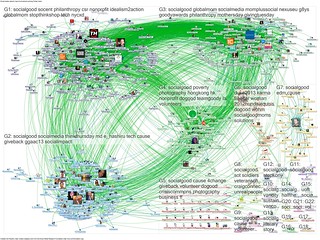Best Practices, Community Spotlights, Community Management Talks, Ning News, Social Media, Quick Tips, Tools & Tech
We all gather in interconnected clusters. You’ve probably seen a cluster map somewhere. There's an example to the right. Think of it like social groups in a playground. Friends gather in circles of 8 to 12 people, but one of those people might have connections to another group of similar size.
There is a cluster of technology types here in London. If you attract a few of them, it’s much easier to attract the rest. They’re in the same cluster.
If you want to grow an online community, find a good-sized cluster of people. Appeal to 3 – 5 members, then invite their support to help attract the rest. Don’t randomly approach people; target specific clusters of people you want to join.
Once you have about 5 – 10 members of a cluster you can set up sub-groups, develop unique content, and specifically appeal to that cluster of people.
(Image: NodeXL-Collection-Twitter-socialgood_2013-05-14_10-45-00, a Creative Commons Attribution (2.0) image from marc_smith's photostream)
